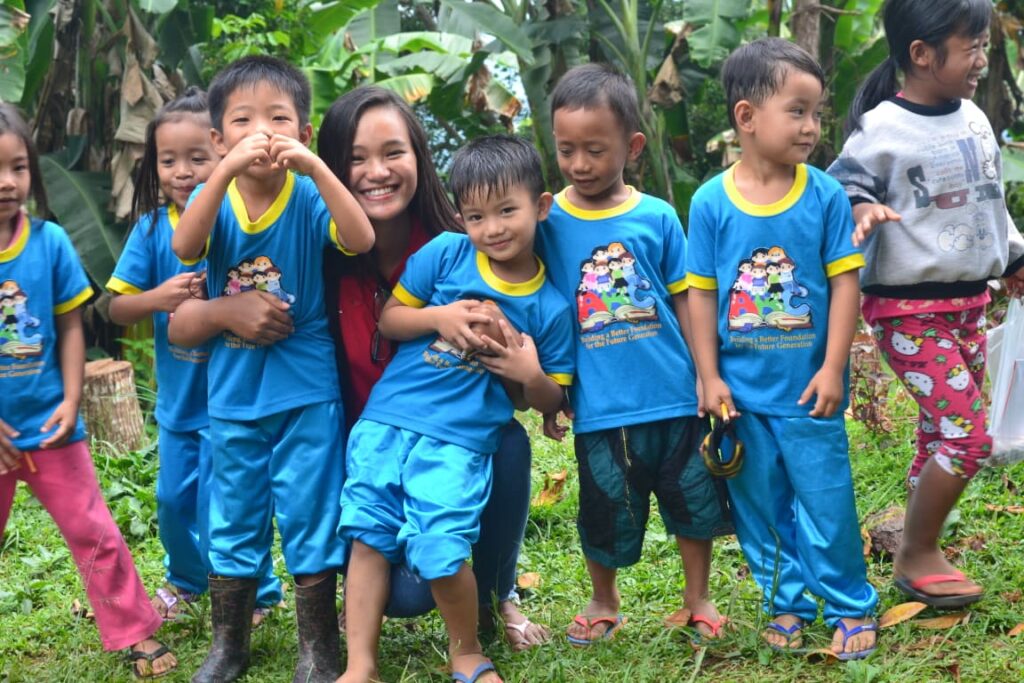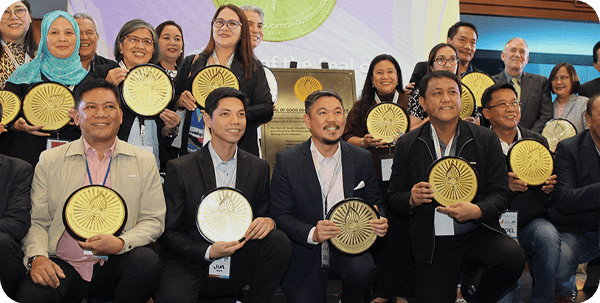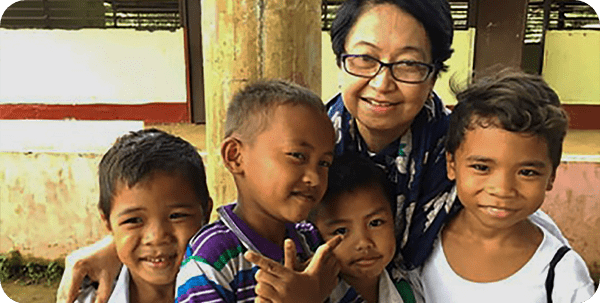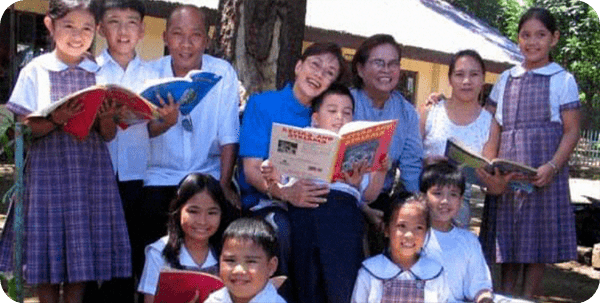
San Gabriel, A Background
The landlocked town of San Gabriel is the largest municipality in the province of La Union. It lies in the highlands of the province. Its mountains are highly attractive to tourists who want to take a dip at its famous falls and to thrill-seekers who want to ride their mountain bikes through its challenging terrains. With agriculture as its main livelihood, crops are mostly highland vegetables and lowland fruits like lanzones and rambutan. The abundance of tiger grass in the town allowed residents to make a living out of making soft brooms. Thus, it became known as the soft broom capital of La Union.
Being a fourth class municipality, the local government maximizes the use of the limited resources within its grasp. Particularly in education, the Local School Board (LSB) works on a very small Special Education Fund (SEF) since the town has a small Real Property Tax (RPT) base. One reason is the many untitled lands in San Gabriel which does not allow the LGU from collecting RPT.
The Wakeup Call
Before San Gabriel became a partner of Synergeia in 2013, the problems of public education in San Gabriel were recurring. It was not only the low rate of enrolment or the low percentage of completion among school children that were worrying. More alarming was the poor quality of education. Then Mayor, Divine Velasco, surmised that the traditional beliefs and practices of parents relying mostly on the teachers for their children’s education, or of the LGU spending education funds mostly on infrastructure, did not solve any of these problems.
Taking a closer look, Mayor Divine saw that there were more and more school-age children who were not enrolled in school. And for those who were enrolled, many did not finish Grade 6. The National Achievement Test results of 64.57% in SY 2014-2015 revealed that the learners were only able to answer 6 out of 10 questions correctly. An alarming 69% of grades 2-6 pupils were frustrated readers. She also realized that funds for education solely came from the SEF. No funds were allocated from other sources such as the general fund.
It was a wakeup call for Mayor Divine. The realization of the poor state of education in San Gabriel sank in when she attended the Synergeia 8th National Education Summit sponsored by USAID at the Ateneo Professional School in Rockwell, Makati in September 2013. She learned in this activity that education breaks the cycle of poverty because educated people earn more, raise healthier children, and get better jobs, better lives and better choices. She understood how Synergeia’s theory of change – the input is led by the LGU which brings about the transformation of educational institutions to be accessible and responsive to needs, and the constituencies are empowered. The output expected are the increase in enrolment and completion rates, and high achievement rates. The outcome would be children become better persons and receiving high quality basic education. She further illustrates the tripartite partnership between the LGU, the citizens and the academe.
And then there was Hope
As soon as Mayor Divine returned to San Gabriel, she immediately concocted a plan on how to have a holistic approach to address the issues of education. Following the Synergeia approach, Mayor Divine organized a consultation dialogue with the LSB and the Local Development Council thru executive meetings. Quickly, they came up with the solution – to create an umbrella program involving the entire community that would focus on improving the state of education in San Gabriel. Mayor Divine believed that there was hope for San Gabriel. Out of this was born Project HOPE (Harmonizing Organizations in Pursuit of Effective Education) – the education reform program of San Gabriel under Executive Order 54 Series 2013. Project HOPE’s objectives are to transform local leadership, establish a more responsive education institution and empower citizenry to establish an integrated community-based project so that every child completes quality basic education.
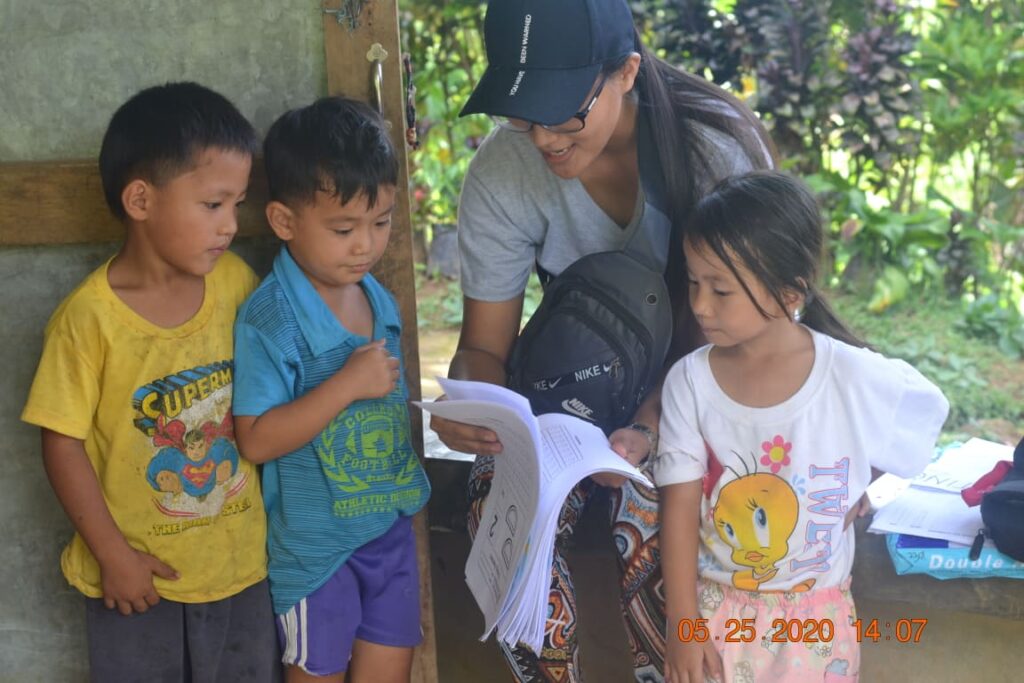
Two months later, on November 18, 2013, Mayor Divine organized the first San Gabriel Education Summit attended by all the elementary school heads and teachers. A Project Management Team was created composed of representatives from various sectors. The LSB membership was also expanded, including all the school heads of San Gabriel, under Executive Order 55 Series 2013. On August 8, 2014, the program was reinforced with the creation of the Bantay Edukasyon Task Force. The composition of the task force was similar to that of the School Governing Council (SGC). On the same day, Project HOPE was presented to all the barangay officials. The task force did home visits with teachers to help pupils who were dropping out or were performing poorly in school. They investigated the reasons for these concerns and helped the learners by connecting the family to the proper agency who can help them.
Like the ripple effect of a small stone thrown in still waters, Project HOPE activities and programs rolled over the years. “Coming together is a beginning. Staying together is progress. Working together is success,” said Mayor Divine, as she highlighted the role of community members in the small and big successes of San Gabriel in education.
It was a long and challenging but a very fulfilling journey for San Gabriel. Since the launch of Project HOPE, San Gabriel would conduct a municipal-wide education summit every year where stakeholders were invited to listen to reports on the state of education and discuss plans to address concerns in relation to the children. For the first time in 2014, Teachers’ Day was celebrated by San Gabriel. A series of trainings was also conducted with Synergeia on school governance by school heads, guidance counselling for school heads, with the help of FMayor Mary Jane Ortega by school heads, and the School Governing Council Regional Workshops.
Project HOPE was indeed the answer. The LGU and the community came up with innovative solutions to specific and general problems. They were able to marry existing programs with new programs so that there was no replication and gaps were filled on areas in education that needed addressing.
For example, the Panangrikna Ti Umili Program of the provincial government improved RPT collection since 2007 because of demand letters sent out quarterly to delinquent tax papers. Because the RPT collection was increasing, the SEF was accordingly increasing as well. But it was not enough. They felt that to do even better, the LGU had to invest more for education. They started to tap the General Fund of the LGU to use for school improvement. They also started to build their donor base by seeking partnership with government agencies, private entities, NGOs/CSOs and individuals so that projects that they could not afford can be funded from external sources. For example, they benefitted from the PDAF of Cong. Victor Ortega and the DPWH.
Passing on the Torch
When Synergeia started working with Synergeia in 2013, Mayor Divine’s Municipal Health Officer was her husband, Hermie Velasco. After her three-term administration ended in 2016, she ran for Vice Mayor while her husband ran for Mayor. They both won! And this is good for San Gabriel because it meant Project HOPE would continue and would even be strengthened. Vice Mayor Divine would ensure that legislation at the Sangguniang Bayan supported the education programs of San Gabriel to the utmost level. They were the perfect tandem. They would often say that their bonding time in the evening was a full discussion of the concerns in the municipality and brainstorming sessions on show they can deal with these concerns.
If former Mayor Divine was a good leader, Mayor Hermie was equally as good. He saw the education situation in San Gabriel as clearly as former Mayor Divine did. He, too, was turned around with his experience with Synergeia. With an open mind and firm determination, education governance took a sharp turn in improving education data such as participation rate, school attendance, malnutrition rate, survival rate, and reading status.
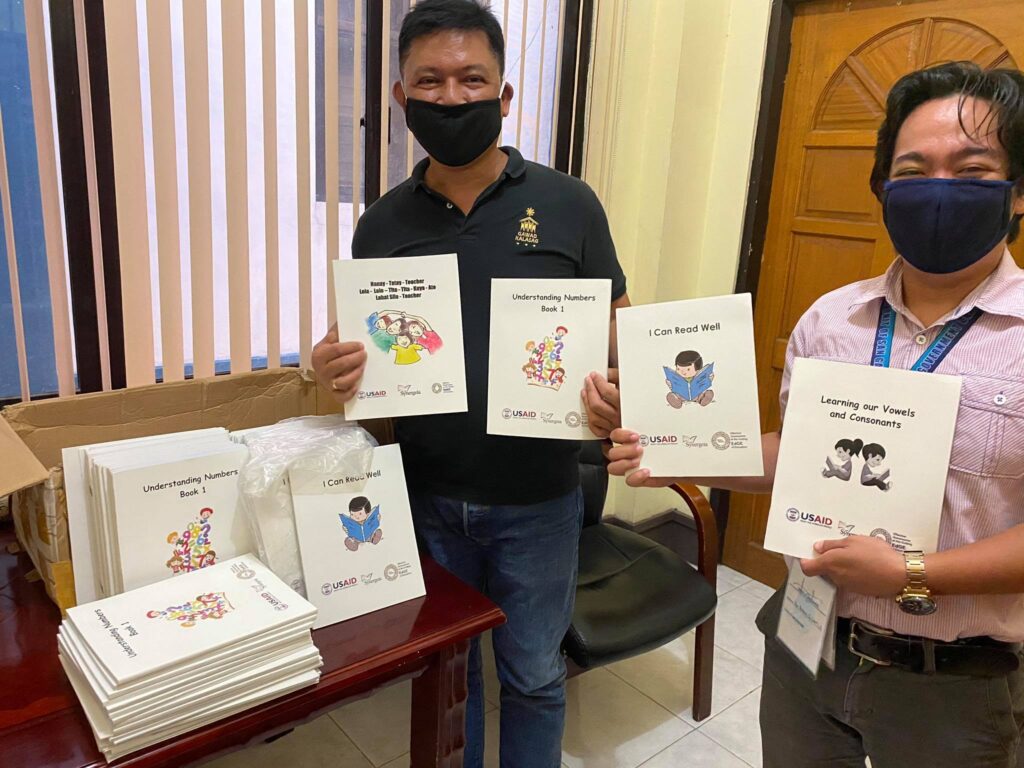
Constantly, in his speeches, Mayor Hermie would passionately tell the story of San Gabriel’s journey in education reform. Being a doctor by profession and having been San Gabriel’s Municipal Health Officer, he always began with how, in 2008, the town had the highest maternal mortality rate in the province. This became his tipping point which motivated him to work closely with health stakeholders to create drastic measures to improve public health in San Gabriel. Their hard work on systematic and consultative health governance has payed off with numerous and consecutive national public health awards such as the DILG’s Seal of Good Housekeeping Award, the NDRRMC’s Gawad Kalasag Award, the DOH’s Red Orchid Award, and the Champion for Health Governance Award from the MSD in the Philippines, Kaya Natin! Movement for Good Governance and Ethical Leadership, and the Jesse M. Robredo Foundation.
Mayor Hermie related their health-related issues a few years back to their education issues. To him, Synergeia Foundation was not only a blessing to San Gabriel but was a huge eye-opener for him and the rest of the municipality when it came to the state of education. He knew that if they succeeded in improving the quality of education in San Gabriel, all the other issues will be addressed. He realized that a leader’s presence inspired greater things from his constituents. Believing that if the community understood the issues, they would be pro-actively acting without being told what to do.
For one, San Gabriel has developed creative ways of generating funds. Mayor Hermie himself takes the time to reach out to potential donors by writing to them personally. There is nothing to lose by writing donors. One good strategy was the listing of San Gabriel’s accomplishments and awards at the bottom of their official letterhead (as shown in the figure below.) These awards are the Seal of Good Housekeeping Awards, Gawad Kalasag Awards and others. This is to show potential funders that the LGU works hard and performs well. Funders and donors tend to immediately develop trust when they see this.
The Turnaround
Mayor Hermie acknowledges the effectiveness of the education programs initiated by former Mayor Divine. He not only continued her programs, he even enhanced them and started new ones. He continued to tap external partners to increase the town’s donor base.
The P10M donation from Congressman Ortega built them a three-story building beside the municipal hall. The third floor was a youth center and e-library. USAID’s Basa Pilipinas became a partner where San Gabriel received instructional materials English, Science and Math for its teachers. The teachers were also trained on computers in partnership with Lorma College. They also received teachers’ manuals and student workbooks from Synergeia.
At the onset of being the LCE and many years before the pandemic, Mayor Hermie already saw the need to invest on technology for education. San Gabriel was selected to be one of 18 towns who will receive public wifi in seven sites. He wanted their high school students not to be ignorant when it came to technology and for them to be aware of what was going on around the world.
Mayor Hermie also saw how imperative it was to engage the parents. After all, education begins at home. Synergeia was requested to conduct a trainers’ training for parent leaders in 2017. These parent leaders were to serve as “multipliers”. At the beginning of the workshop, there were some glaring observations by the parents. Some of them realized that they made the mistake of comparing their children with their siblings. Some admitted that they rarely spent quality time with their children. Some regretted that they would sometimes take their anger out on their children. Some were over-protective of their children. But they also took pride that some of them regularly read with their children and would often tell their children they love them. At the end of the workshop, Mayor Hermie humbly begged the help of the parent leaders by saying, “Kahit magaling ang liderato, ang LGU at ang barangays, kung hindi magpa-participate ang parents, wala po tayong lahat.”
Transformation from Within
The SGCs are on a roll!
Mayor Hermie knew that the best ideas came from the ground. Knowing also that Synergeia’s approach was bottom-up, he made sure his constituents were present in all Synergeia trainings. These trainings provided venues for the education stakeholders to reflect on the state of education in their town and brainstorm on creative ways using minimal resources to make education work for the children.
The series of SGC Workshops were extremely helpful in getting school communities together. For the first time, the school heads, teachers, barangay leaders and PTA officers understood the implication of the education statistics of the school. For example, they were able to analyze together the reasons for the low cohort survival rates. They attributed these figures to migration of families due to livelihood, the distance of homes to schools, poor family support for children’s education, child labor, malnutrition and poor health conditions, and peer influence. The low NAT scores were believed to be caused by high class sizes at the central schools and lack of training of teachers.
Getting the SGCs of San Gabriel to be functional was not easy at first. Moving forward was difficult because of the volunteer members’ busy lives and the distance of homes to the schools. They also admitted that their lack of knowledge and skills in governance was the biggest hindrance to fully functioning. But their lack in these areas were made up for by their commitment to get better. They started meeting more often, and involving more members in the planning, implementation and evaluation of programs.
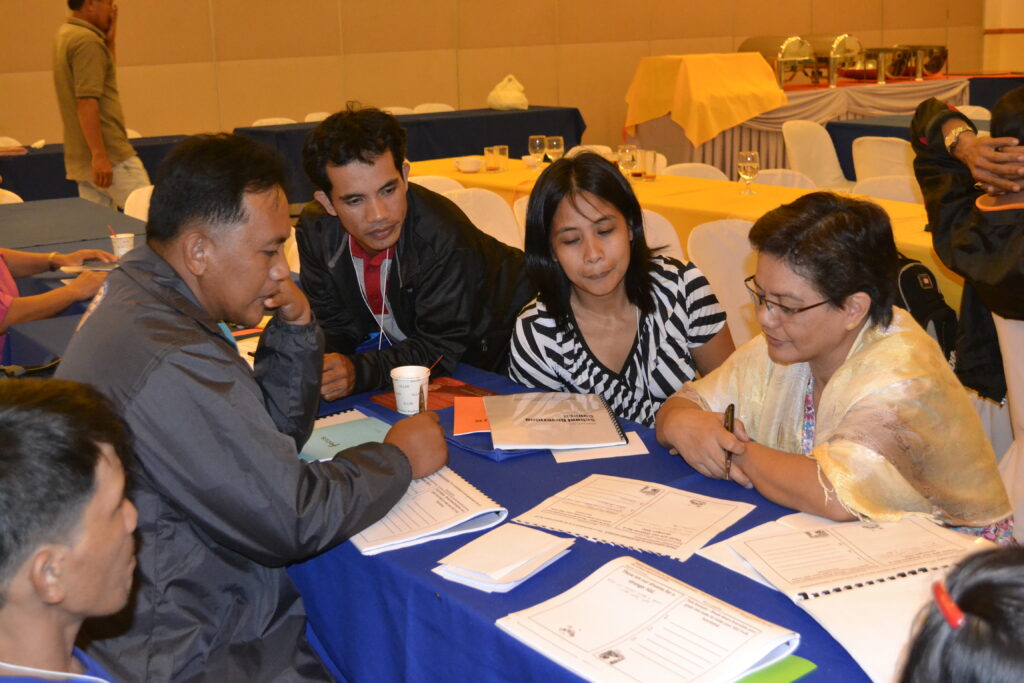
For Lon-oy Elementary School, Principal Isagani Sayan explained how he did it in his school. He conducted a general assembly where they invited representatives from the religious sector, farmers, alumni, PTA, senior citizens, barangay LGU, students, Barangay Health Workers, and retirees. This was followed by an election of officers. After this, the SGC made sure that they were meeting regularly. They then came up with policies on children’s discipline, maintenance of school properties and school security. He said that he was in disbelief of how engaged the alumni based abroad were through the school’s Facebook page. These alumni are a major source of cash donations. The SGC was able to achieve a lot in a few years. They rehabilitated the community stage, they did fundraising activities such as the sale of soft brooms. This eliminated the need to solicit help from parents. They built a fish pond in the school in partnership with the farmers’ association to have access to a water source. This fish pond generates income for the school.
We heard so many success stories of the SGCs. For instance, because the SGC members understood the education data of their schools better, they were able to come up with great ideas to start solving their problems. They began disseminating these data to all the parents and community members during their general assemblies. They included transparency measures of reporting on the breakdown of MOOE and SEF expenses to the barangay officials.
In one school, the pairs of parents took turns in guarding the schools because there were no funds available to hire a security guard.
The issue of drunk students was problematic for some principals. But with the barangay leaders as SGC members, the barangay drafted a barangay ordinance prohibiting the sale of liquor to minors. Problem solved! They did the same in the ordinance prohibiting the sale of softdrinks and junk food to school children.
Pre-pandemic, the SGCs of San Gabriel accomplished so many other projects that helped the school children such as building of water systems, covered courts, reading kiosks, roofs, gates, stages, fences, pathways, ripraps and arches. Some were able purchase sound systems and musical instruments. While others conducted values education classes, feeding, library, and remedial reading programs for the children.
LSBs and SGCs in synchrony
The LSB also took their operations to the next level. In a 5-point self-assessment scale where the LSB members evaluated their performance in terms of leadership of the mayor, regularity in conducting meetings, richness and varied agenda, collaborative agenda preparation, systems, processes and structure, initiation of education financing programs, leadership in education programs, community engagement, and expanded membership, the LSB rated themselves a 3 in 2013. With a lot of work and a deep commitment and engagement, the self-assessment results improved through the years and reached a perfect 5 by 2017. This helped tremendously in San Gabriel being awarded the Jesse Robredo Excellence Award in Education Governance in 2018, and the Seal of Good Education Governance in 2019 and 2020-2021.
The Chair of the Committee in Education thought that, “Ti edukasyon ket isu ti kai-importantean nga banag iti panagdur-as ti maysa nga tao,” (Education is the most important thing a person can have in his life.).
To be able to get to the level where education would work for the children, the first thing that they did in 2014 was to expand the membership. They included all the principals of the public high school and elementary schools, the PTA Federation President, ABC president, DSWD representative, as a start. Yearly, they would add new members to further strengthen its membership.
The meeting agenda and program implementation now went beyond “business as usual”. Aside from budgeting and sending athletes to the Palarong Pambansa, they started off with having an annual municipal-wide education summit to discuss the state of education in San Gabriel. These reports were echoed in barangay and school assemblies as well.
The LSB was now discussing education data with much focus on the problems of school children in reading which they resolved thru a summer reading camp and remedial reading program. They also discussed scholarships for almost 200 financially-challenged senior high school students where they were given uniforms and cash assistance to ensure they continued their education. The LSB also talked about how to make K-12 work for the students. They also discussed the major concern on how to encourage students to enroll and stay in school to resolve their issues on participation and dropout rates. The LSB reviews the School Improvement Plans (SIPs) submitted by the SGCs, prioritize the proposed projects according to urgency and impact and allocate funds for the selected priority projects. They implemented health programs for children such as the Lingad Mata project for children with sight problems, and the LSB’s feeding program under the Kusina ng Kalinga Program of Gawad Kalinga to ensure 700 students were catered to daily in the upland schools. They even talked about the safety of old school buildings. They also helped in the annual Brigada Eskwela and organized a yearly recognition of outstanding teachers. All these, of course, went under the umbrella program, Project HOPE.
The LSB knew that they had meager resources if they were only to use the SEF and a small portion of the General Fund. They knew they had to do more. They started promoting the intensification of RPT collection by encouraging the townspeople to pay their taxes at school and barangay assemblies. The LSB brainstormed on donors who could help them with specific projects such as scholarships and Brigada Eskwela. The schools even hosted fundraising activities to contribute to the expenses.
The barangay as a potent venue for education reform
The barangay captains and kagawads on education were also met by Mayor Hermie in 2015 where he emphasized the triangle of capacity development where the partnership is between the LGU, the community and Synergeia. In this meeting, they discussed the current sources of funds for education – the SEF and the LGU’s general fund. It was stressed that this was inadequate if they were to truly make a difference. It was a matter of sensitizing themselves based on evidence and learning to prioritize expenses, Mayor Hermie said. They looked at the other possible sources of funds such as the 10% Sangguniang Kabataan fund which usually goes into basketball uniforms during barangay play-offs. They thought that the amount would be more impactful if it went into children’s workbooks. They also saw that the 20% Development Fund can be tapped in the repairs and building of ripraps in schools. The 5% Barangay Disaster Risk Reduction Management fund can be used to repair schools damaged during disasters like typhoons. The 1% Barangay Council for the Protection of Children and 1% Senior Citizen funds may be utilized for reading programs or nutrition programs for children.
Synergeia helped the barangay leaders by capacitating them in a workshop. The barangay participants learned that on top of all the possible sources of funds, the Sangguniang Barangay has the duty and power to legislate and adopt measures on programs for the proper development and welfare of children. Barangay assemblies are powerful in getting the community members on board in the governance of education.
They also learned that the COA rules on barangays being disallowed from financing school projects outside of their barangay jurisdiction, they can circumvent this by presenting a cost-benefit ratio and legal documents such as citing Section 16 of the Philippine Constitution on the general welfare clause, MOA with the school and the barangay Annual Implementation Plan for proper liquidation. Furnishing the Sangguniang Bayan and the Municipal Planning and Development Office with these documents allows these offices to help the barangays justify the projects.
When the barangay leaders joined Synergeia’s SGC Workshops, they realized the importance of benchmarking where they check on the best practices of other barangays, schools or LGUs and use whatever knowledge or skill they pick up if it applies to their situation. He said, “It’s not wrong to copy other groups because in the end, what works best will unravel itself.” They also realized the importance of good communication lines between the barangay and the school, and the barangay and its constituents, especially in education.
The barangay now plays a great role in education in San Gabriel. Some barangays implemented Bantay Bata Project for the security of children and some created ordinances to ensure children cannot enter internet shops during school hours. The barangay officials now join teachers in visiting homes where the pupils struggle in school. From the barangay funds, they have allocated portions to help schools in their education programs. Inter-barangay collaboration has also been done to make sure each child is covered even if their school is located in another barangay.
Nothing Could Stop Us Now
The pandemic was not a deterrent to San Gabriel. Even at the onset of the Enhanced Community Quarantine (ECQ) in April 2020 and way before DepEd decided on how to continue providing education to the children, the community members of San Gabriel decided to provide learning access to the children, especially in the most remote locations where Covid was not an issue. Specifically, the community members of Barangay Daking, composed of teachers, college students and the barangay officials, volunteered to create their own learning modules, printed them, and hiked to the homes of the children to teach them reading, math and science.
The LSB, on the other hand, immediately, re-aligned the SEF to accommodate the needs of the schools for distance education. The school heads and teachers started contextualizing the module content given by DepEd to simplify and make the lessons more comprehensible to the students.
To this day, the LSB, SGCs, parents, teachers and barangay leaders, work together to make learning work against all odds. Mayor Hermie continues to work on setting up a community radio station so that audio lessons can reach the farthest homes. The SGCs and barangay officials continue to help in the distribution and retrieval of modules. The community volunteers provide tutorials to students who struggle with their printed modules.
It Takes a Village to Educate A Child
Often, we would hear education stakeholders from other LGUs state how lack of funds is the biggest barrier to improving the quality of education in their municipality. Now we can disagree with that statement because San Gabriel has proven them wrong. Their wealth in human resources more than makes up for the lack in financial resources. The involvement and engagement of the entire community, with the transformation starting from within, was the secret ingredient to their continued success in education.
